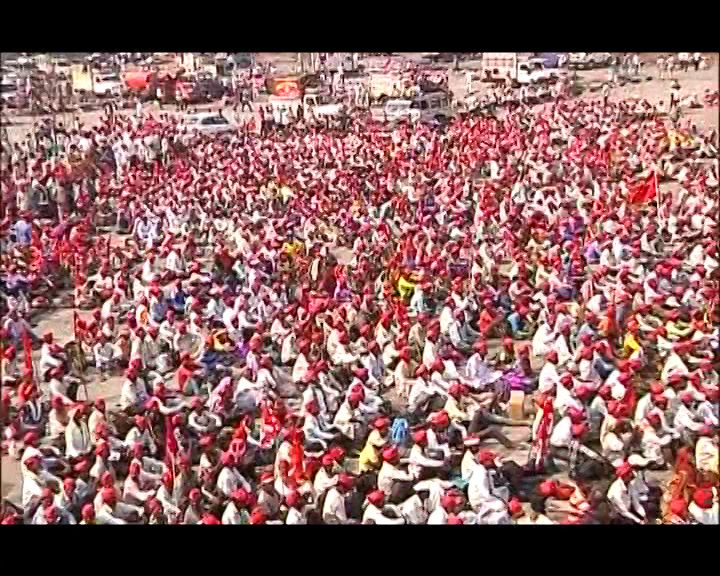Reading Time: 3 minutes
During last four years of Modi government rule, in spite of long sustainable movement, the government continues to be unmoved. Thousands of subsistence level farmers and peasants committed suicide, but these deaths did not have any impact on the government. A report, for Different Truths.
Like his illustrious leader, Union agriculture minister Radha Mohan Singh is also a brainy politician and can dare to come out with any statement. Taking a leaf out of his past experience, he described the two-day-old farmer agitation as a publicity stunt. According to him, the farmers resort to such gimmicks only for cheap publicity. Singh said, “Any organisation will have 500, 1,000, 2,000 or 40,000 farmers, and they have to do something unique to appear in the media. The country has 12 to 14 crore farmers and an agitation by a few would have no impact.”
During last four years of Modi government rule, in spite of long sustainable movement, the government continues to be unmoved. Thousands of subsistence level farmers and peasants committed suicide, but these deaths did not have any impact on the government.
Not only Singh, the BJP and NDA leaders have been trying taking a similar stand. MP agriculture minister Balkrishna Patidar has also accused the farmers of playing gimmick. According to him, the farmers are happy with the chief minister’s schemes. How could these leaders forget the brutal killing of farmers in Mandsaur of MP in June last year? The most outrageous statement came from Haryana Chief Minister Manohar Lal Khattar, who said the farmers were protesting unnecessarily and that not selling vegetables and milk would only result in their own loss.
The saffron insensitivity to farmers’ cause and problems has been appalling. During the four year rule of the Modi government, the country witnessed thousands of farmers committing suicide and farmer organisations taking to streets demanding a fair deal. The latest farmers’ movement has spread to a number of states. Around 185 peasants’ and farmers’ bodies across northern and western India have decided not to sell their produce from June 1 to 10.
Even while the farmers’ were agitating, two debt-ridden farmers in MP committed suicide. To press their demands the farmers’ resorted to ‘gaon bandh’ agitation in northern and central states. Farmers from Punjab, Haryana, Madhya Pradesh, Maharashtra, Rajasthan and western Uttar Pradesh dumped their vegetables and milk on the roads. They have been demanding the implementation of the Swaminathan Committee report, which proposed cost price plus 50 percent of the amount for the produce. The last four years have witnessed the lowest-ever agriculture growth, 1.9 percent, compared to the previous 4.2 percent. According to an RBI report, the rural wage growth has dipped from 38 percent in 2014 to zero percent in 2018.
On March 6, about 40,000 subsistence farmers and landless peasants had marched to Mumbai from Nashik. This rally for the first time during NDA rule captured national attention. Most of the farmers walked barefoot in protest. The people of Mumbai offered packets of food and water to them.
Agrarian distress has been eroding the base of rural population. The distress was clearly brought out by the 2011 national Census. It recorded nearly 15 million fewer farmers compared to 1991; that’s a drop rate of about 2,040 every 24 hours. Many of those fell from being farmers to being landless agricultural labourers, into the ranks of the agrarian underclass. The cultivation costs have risen manifold since the mid-1990s, but the farmers’ incomes have declined. The corporations and agro-businessmen have been thriving on the miseries of the farmers and peasants.
The Census showed that for the first time since Independence, urban India added more people to its population than rural India. Millions have left their villages for small towns and cities in search of jobs. As male farmers moved out of their villages, the burden on female farmers rose in ways numbers cannot capture. Between 1995 and 2015, the National Crime Records Bureau logged over 300,000 farmer suicides.
It is not that the Modi government and RSS leaders were unaware of these. While the number of Indian billionaires on the Forbes annual list rose from 55 in 2011 to 121 in 2018, the number of landless labourers consistently increased.
The National Commission on Farmers, headed by M S Swaminathan, submitted detailed reports more than a decade ago. But the lawmakers are yet to have a day’s serious debate on the reports and recommendations. There is the need for a special session of Parliament on the agrarian crisis and the related issues.
More than half of India’s population of 1.3 billion is engaged in agriculture and allied sectors, but their contribution to national income has been dwindling rapidly. Over the past two decades, thousands of indebted farmers have committed suicide. As Swaminathan pointed out, loan waivers and such measures do not provide the conditions for a secure credit system in the long term. The waiver of loans implies that banks will have to be compensated by the government for the amount involved. This means that large sums of money, which could otherwise have gone to strengthen agricultural infrastructure will not be available.
Arun Srivastava
©IPA Service
Photo from the Internet
















